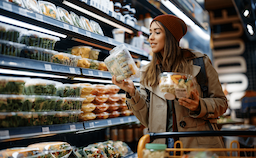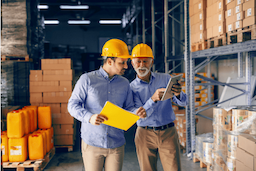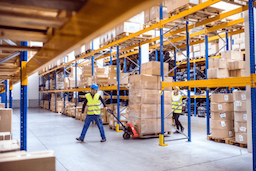October 1, 2021
Wrap Up: The Evolution of Packaging Materials and Designs

Packaging, the technology, and the art of preparing the artifact for convenient transport, storage, and sale, has an exciting journey along with the beginning of humankind. Close observation reveals that the development of packaging materials and packaging designs evolved around the culture, global epidemic, and consumer behavior widespread around a given period. Let us look at how packaging has evolved.
Ancient & Medieval era (up to-20th century)
People produced and consumed most of the food locally during ancient times, so the food packaging was unessential. Ancient civilizations used vessels and containers made of natural materials like lotus leaves, shells, bamboo, palm leaves, gourds, coconut shells, and animal skin. Later on, there were discoveries of ores, minerals, and chemicals, leading to new packaging materials.
The Era of Dual-Use Packaging – Packaging for only high-value goods like jewelry, gift items, shoes, and premium foods. As the packaging materials were indispensable, people structurally designed these to serve dual functions after product use.
Building Brand Identity (1890-1910) –With rising trade, the phrase-” let the buyer beware” became popular. Hence, manufacturers turned to use packaging in innovative ways to establish their brand identity.
The Era of “Silent Salesman” (1920-40) –The rise of low-cost and clean packaging solutions allowed huge retail chains to come in who displayed products on the shelf.
Convenience as the Motivation (1950-70) –After the second world war, the consumer market exploded with the continuous innovations in aluminum and plastics. Hence modern-looking packaging materials were available at lower prices compared to traditional materials.
The Rise of Digital (1980-2000) – This era saw the rise in computing abilities and the evolution of printing technologies. As a result, execution and rapid scaling of business became possible. The growing fascination with plastics led to innovation in packaging designs, shapes, and materials that paved the way for use-and-throw behavior. Hence the non-decomposable packaging waste became the primary constituent of landfills.
Current Packaging Trends (21st century)
Environmentally Friendly Packaging (The Early 2000s)– The Environmental Protection Agency created stringent laws for businesses to reduce environmental impacts. Finding sustainable materials for environmentally friendly packaging and optimizing waste became a prime agenda. The industry started moving towards the circular economy from the linear economy.
2007-2021– A faster pace of life translated into consumption “on the go,” which, naturally, increased the need for packaging material for food. Let us look back at some of the best trends we have seen happening so far! Digital Printing – Digital printing enabled more options in personalization and customization when compared to other techniques. Examples of such personalization include Coca-Cola printing of customers’ names on the soft drinks containers.

We cannot talk about 2020 without talking about clean labels. Providing product information in a clear, concise, and transparent way augmented customers’ trust in the company’s brand name.
Coronavirus and Food Packaging- The COVID19 outbreak forced the surge of new developments. How long does the covid virus last on cardboard boxes? Does freezing kill coronavirus on food packaging? These questions aroused the greater interest of food brands and customers alike. Many food delivery brands experienced a rise in demand for new packaging ideas for food like disposable plastic packaging for food. The packaging industry focused on innovating packaging material for food to help food brands to meet these demands.
Touchless packaging – The pandemic has also accelerated the development of touchless packaging and operations like the design of touchless dispensers, touchless manufacturing & packaging of pharmaceutical instruments, personal protective equipment (PPE).
The Future of Packaging
The global packaging market is expanding with a 2.8% CAGR to reach US$1.05 trillion by 2024. Let us have a look at certain advancements which seem to dominate the future packaging market.
Optimized packaging solutions (Space and material saving) – Designing optimized packaging which occupies less space with thinner & stronger design, as storing and transporting mass amounts of packaging is also seen as less eco-friendly.



Smart packaging – Rise in the internet of things, RFID, biosensors, screens, compact power sources, and data storage will enable companies to receive comprehensive information on consumers and valuable data on buyer groups.
RFID tags relay information on the real-time location of product packages up to a distance of 100 meters and enable accurate product tracking. With blockchain, supply chain companies can document production updates to a single shared ledger for complete data visibility. Transactions are time-stamped and therefore businesses will be able to track a product at any time.
Edible packing – Use of natural polymers in food packaging, which are biodegradable, do not generate residue, have a low environmental impact, and are consumed by humans. Materials in use include polysaccharides, proteins, lipids, or composites.


Water Soluble packaging –Such packaging materials will dissolve in hot water. The main ingredients in this bio-based material are polyvinyl alcohol or PVOH, a synthetic polymer created without the heavy toxic metals to act as an alternative to plastic packaging like shopping bag retail packaging.
Self-cooling and Self-heating packaging – The package will self-heat and cool without an external heat source or power. It will be suited for military operations & natural disasters. The science behind this is an exothermic chemical reaction between anhydrous calcium chloride and water.
Active packaging / Antimicrobial packaging – With a CAGR of 6.62%, this market may reach a size of US $31.924 billion in 2026 from the US $20.386 billion in 2019. It will involve the addition or withdrawal of certain gases and liquids within food packages, which will inhibit the growth of pathogenic microorganisms and prolong the shelf life of food.
E-commerce Packaging – The e-commerce shopping experience will become more and more tailored to the customer allowing brands to accommodate their target market even further through packaging. Coming out of the pandemic, there is likely to be a surge in demand for sustainable packaging solutions. In fact, 82% of customers will likely prefer to receive their online order in cardboard boxes over poly bags.


Corrugated Packaging – To achieve sustainable goals, there will be a steep increase in applications for corrugated packaging materials. It will add up to a big win for corrugated box packaging. (30)
3D Printing – 3D printing will allow the packaging industry to manufacture for a much lower price by integrating manufacturing, warehousing, overseas shipping costs, and CO2 emission reductions. (27)
Wrap Up: Rise of Digitally Integrated Packaging Supply ChainsComing out of the COVID19 pandemic, technology integration in packaging will embrace new standards like digitally printed and serialized bar codes, variable data printing, and IoT. Higher technology integration will allow businesses and customers alike to have greater visibility and control on not only their product packaging but also performance metrics like product shelf life, wastage, costs, carbon footprint, and turnaround time across the end-to-end supply chain.



